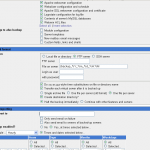If by chance you have installed the Webmin module Virtualmin at some point you may have come across the following error message when setting up the module:
Failed to save enabled features: The Suexec command on your system is configured to only run scripts under /var/www, but the Virtualmin base directory is /home. CGI and PHP scripts run as domain owners will not be executed.
This error message is caused by using a version of suEXEC compiled by default to use /var/www as the document root of Apache. The suEXEC feature allows to execute scripts as the user owning the virtual host instead of the global apache user increasing security. The solution has either been to recompile suEXEC with the new desired path (/home in this case) or simply disable (Server Templates > Apache Website > Automatically add appropriate SuExec directive?) suEXEC completely inside the Virtualmin module configuration.
A much simpler approach I used was to create a link between the two directories. I used mount to bind the two directories together and act as one. Voila, Virtualmin now continued the module setup without a remark!
To achieve this I ran the following command as root:
mount --bind /var/www /home
That is it really. Now the directories act as one for the suEXEC wrapper too.
Please note this will usually only last till next reboot. To mount permanently include the following line into your /etc/fstab:
/var/www /home none bind
The following is the extract from the mount man page:
Since Linux 2.4.0 it is possible to remount part of the file hierarchy somewhere else. The call is
mount --bind olddir newdir
or fstab entry is:
/olddir /newdir none bind
After this call the same contents is accessible in two places. One can also remount a single file (on a single file).
One note is that if you already had local users set up inside the /home directory you will mount on top of it, making the existing users data unavailable (not deleted). Simply unmount again and the users data will be back again. To get around this change the default path Virtualmin uses to create new virtual hosts home directories to something else e.g. /virtualmin. This can be done in the Users & Groups module.
